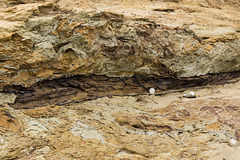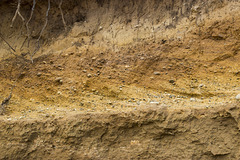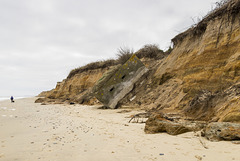
Sedimentary structures
Folder: Geology and Earth Science
Photos illustrating sedimentary structures such as cross-bedding, ripples, channels, unconformities, etc.
Benacre cliffs: Norwich Crag cross-bedding detail
| |
|
Close-up view of cross-bedded sands and gravels of the Norwich Crag (early Pleistocene) at Benacre Cliffs, just north of Covehithe in Suffolk.
Height of section: approx. 1.3 metres. Full view of cliff here:
www.ipernity.com/doc/earthwatcher/39078910
Benacre cliffs - Norwich Crag cross-bedded sands
| |
|
Cross-bedded sands and gravels of the Norwich Crag (early Pleistocene) at Benacre Cliffs, just north of Covehithe in Suffolk.
This stretch of coast line is currently experiencing the most active coastal erosion in the UK, with average loss rates of around 7 metres per year. The cliffs are only recently formed and are growing in height. The land behind the cliff line is a gentle hill, therefore as the sea eats into the cliff line causing it to retreat westwards into the hillside, so the top of the cliff gets higher.
Norwich Crag at Benacre cliffs
| |
|
Benacre Cliffs, just north of Covehithe in Suffolk, are comprised of sands and gravels of the Westleton Formation, with beds of bioturbated clay; part of the Norwich Crag, early Pleistocene in age.
This stretch of coast line is currently experiencing the most active coastal erosion in the UK, with average loss rates of around 7 metres per year. The cliffs are only recently formed and are growing in height. The land behind the cliff line is a gentle hill, therefore as the sea eats into the cliff line causing it to retreat westwards into the hillside, so the top of the cliff gets higher.
Benacre Cliffs - Norwich Crag bioturbated clay wit…
| |
|
Benacre Cliffs, just north of Covehithe in Suffolk, are comprised of cross-bedded sands and gravels of the Westleton Formation, with beds of bioturbated clay; part of the Norwich Crag, early Pleistocene in age. Here, a fossil tree branch can be seen in the clay. 20p coin for a scale.
Benacre Cliffs cross-bedded gravels 2
| |
|
Cross-bedded sands and gravels underlain by bioturbated sandy clay. Westleton Formation; part of the Norwich Crag (early Pleistocene) at Benacre Cliffs, just north of Covehithe in Suffolk. Above the cross-bedded unit, blown sand merges into modern soil.
Benacre Cliffs cross-bedded gravels 1
| |
|
Detail of cross-bedded sands and gravels of the Westleton Formation; part of the Norwich Crag (early Pleistocene) at Benacre Cliffs, just north of Covehithe in Suffolk.
Collapsed pill box at Benacre Cliffs
| |
|
Benacre Cliffs, just north of Covehithe in Suffolk, are comprised of cross-bedded sands and gravels of the Westleton Formation, with beds of bioturbated clay; part of the Norwich Crag, early Pleistocene in age.
This stretch of coast line is currently experiencing the most active coastal erosion in the UK, with average loss rates of around 7 metres per year. The cliffs are only recently formed and are growing in height. The land behind the cliff line is a gentle hill, therefore as the sea eats into the cliff line causing it to retreat westwards into the hillside, so the top of the cliff gets higher. The collapsed WW2 pill-box illustrates the erosion process.
Benacre Cliffs - Westleton Formation
| |
|
Benacre Cliffs, just north of Covehithe in Suffolk, are comprised of cross-bedded sands and gravels of the Westleton Formation, with beds of bioturbated clay; part of the Norwich Crag, early Pleistocene in age.
This stretch of coast line is currently experiencing the most active coastal erosion in the UK, with average loss rates of around 7 metres per year. The cliffs are only recently formed and are growing in height. The land behind the cliff line is a gentle hill, therefore as the sea eats into the cliff line causing it to retreat westwards into the hillside, so the top of the cliff gets higher.
Canisp from Creag Dharaich
| |
|
A fine evening looking over the chaotic knock-and-lochan landscape of the Lewisian Gneiss foreland towards Canisp one of the relict Torridonian Sandstone mountains. The red Torridonian Sandstone of Canisp lies unconformably on the Lewisian Gneiss and is itself unconformably overlain by the pale grey Cambrian Basal Quartzite just visible on the summit.
A south-easterly view from the Creag Dharaich viewpoint near Lochinver, Sutherland, Scotland.
Quinag: Cambrian Basal Quartzite - Torridonian unc…
| |
|
A day on Quinag - photo 24 .
On the descent and walk out, we stop to examine the contact of the Cambrian Basal Quartzite (the sloping grooved under-surface) resting with angular unconformity on the Torridonian Sandstone (late Precambrian) exposed in the low crags of Druim na h-Uamha Mòire at NC 22673 28186.
A fascinating end to a splendid day!
Quinag: Cambrian Basal Quartzite - Torridonian unc…
| |
|
A day on Quinag - photo 23 .
On the descent and walk out, we stop to examine the contact of the Cambrian Basal Quartzite resting with angular unconformity on the Torridonian Sandstone (late Precambrian) exposed in the low crags of Druim na h-Uamha Mòire at NC 22673 28186.
Quinag: Spidean Còinich from Sàil Gharbh summit
| |
|
|
A day on Quinag - photo 17 .
The magnificent view to the south from summit of Sàil Gharbh (808 m), looking towards Spidean Còinich, the southern spur of Quinag with Lochan Bealach Cornadh at its foot. In the distance are Canisp (middle left), Cùl Mor and Suilven. Loch Assynt, The Minch and the Summer Isles are visible on the right.
The upper part of Spidean Còinich consists of the pale grey Cambrian Basal Quartzite (Eriboll Formation) dipping at around 15° east (left) which rests with clear angular unconformity on the nearly horizontally bedded Torridonian Sandstone (Applecross Formation). The same unconformity is also seen on Canisp in the distance.
Quinag: Spidean Còinich and Lochan Bealach Cornadh
| |
|
A day on Quinag - photo 9 .
Spidean Còinich and Lochan Bealach Cornadh viewed from part way up the south-east flank of Sàil Gharbh.
Quinag: Spidean Còinich
| |
|
A day on Quinag - photo 2 .
Looking west to Spidean Còinich (764 m), the southern spur of Quinag and an impressive looking mountain it is too.
All the Quinag spurs are capped by pale grey Cambrian Basal Quartzite (Eriboll Formation) resting with angular unconformity on the red Torridonian Sandstone (Applecross Formation) beneath.
Taken from the car park next to the A894 at Grid Ref. NC 2329 2736.
Quinag: start of the walk in
| |
|
A day on Quinag - photo 1.
The start of the walk in. Looking west to the Quinag massif from the car park next to the A894 at Grid Ref. NC 2329 2736.
Spidean Còinich (764 m) is the mountain to the left of centre, Sàil Gharbh (808 m) to the right. The path leads up to the bealach (Bealach a' Chornaidh) in the centre. A long way to go yet!
Quinag and Loch a' Chàirn an Bhàin
| |
|
|
The north faces of Sàil Ghorm (right) and Sàil Ghàrbh (left) , the two northern spurs of Quinag, with Loch a' Chàirn an Bhàin in the foreground, taken from near Kylestrome at grid ref. NC 21161 34782.
Quinag is comprised of Torridonian Sandstone resting unconformably on Lewisian Gneiss which forms the rough hummocky ground in the foreground and middle distance. The very summit of Sàil Ghàrbh is comprised of pale grey Cambrian Basal Quartzite, also resting unconformably on the Torridonian Sandstone. So there is a double unconformity in this photo.
Suilven from Stac Pollaidh ridge
| |
|
|
Suilven and the mountains of Assynt beyond, viewed from the Stac Pollaidh ridge. Loch Sionasgaig is in the foreground.
Suilven is comprised of Torridonian Sandstone which rests unconformably on the high-grade metamorphic basement rocks of the Lewisian Gneiss which forms the 'knock and lochan' landscape in the middle ground. There is a time gap of about 700 million years separating the two rock units.
Storm beach at Aberbach, Pembrokeshire, Wales.
| |
|
Originally uploaded for the Guesswhere UK group.
An excellent storm beach at Aberbach, a nice secluded spot on the north-west Pembrokeshire coast. There is no vehicular access to this place.
Jump to top
RSS feed- Latest items - Subscribe to the latest items added to this album
- ipernity © 2007-2024
- Help & Contact
|
Club news
|
About ipernity
|
History |
ipernity Club & Prices |
Guide of good conduct
Donate | Group guidelines | Privacy policy | Terms of use | Statutes | In memoria -
Facebook
Twitter


















